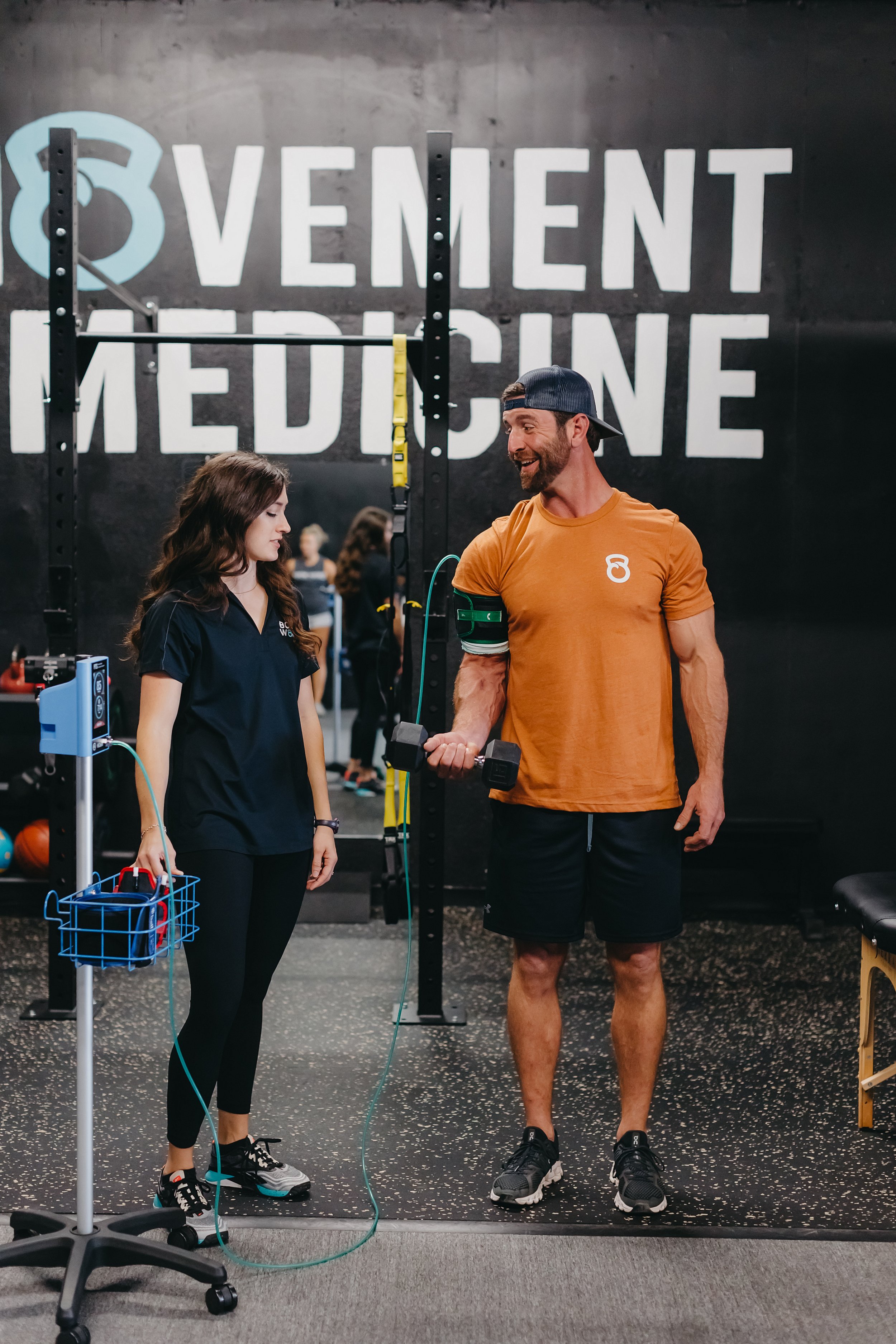Blood Flow Restriction Training (BFR)
Personalized blood flow restriction training is a game-changing therapy that utilizes specialized tourniquets to safely regulate & control arm or leg occlusion pressure for some pretty amazing training outcomes! 💪🏋️ In short, BFR allows you to exercise & lift at lower loads (20-30% 1 RM) with similar results you would achieve when lifting 65% or greater of your 1 rep max 🤯
Many individuals we see at BWPT have limitations and precautions associated with injuries, surgery, or disease processes that would make traditional strength training difficult or even impossible to perform. With BFR, we can work at much lower intensities and still see significant improvements in function and performance.
Research on traditional loading requirements for hypertrophy (muscle mass gain) during weightlifting suggests loads heavier than 65% of an individual’s 1 rep max must be used to create hypertrophy gains. For example, if someone has a 1 rep max back squat of 200#, they would need to squat loads greater than 130 lbs to create a hypertrophy response. However, if lifting with BFR, this same person would only have to squat at loads of 40 lbs to achieve similar hypertrophy results! This is great news when it comes to rehabbing an injury that cannot be heavily loaded, or after having surgery.
At BWPT, we use BFR to help our clients:
* Diminish muscle atrophy and loss of strength from disuse following injury or surgery
* Increase strength and muscle mass with light loading (only 20-30% of 1 Rep Max). Without BFR, this typically requires training at loads of 65% 1RM or greater!
* Improve muscle endurance in 1/3 the time
* Improve muscle protein synthesis in the elderly
* Improve strength and hypertrophy after surgery
* Improve muscle activation
* Increase growth hormone responses
* Improve performance!
How it works
When using BFR, individualized pressure is determined utilizing specialized BFR cuffs. We personally use Delfi and Smart Cuffs at BWPT. These specialized cuffs allow us to determine and maintain a very specific occlusion pressure throughout the duration of exercise, which allows for optimal results & maintains safety. The cuff is placed around the upper arm or upper leg, then inflated to the specific pressure that reduces arterial blood flowing into the limb by 50% - 80%, and completely restricts all blood flowing out (venous return). The decreased blood flow results in less oxygen to the limb. Exercising the muscles in this low oxidative state allows the athlete to use very light resistance, yet achieve strength gains similar to exercising under heavy loads, or high intensity.
What's the science behind BFR?
There are several proposed mechanisms to how BFR works for hypertrophy that are too detailed for this blog, so we'll keep it simple by starting with this formula:
MUSCLE PROTEIN SYNTHESIS – MUSCLE PROTEIN BREAKDOWN = AMOUNT OF MUSCLE GROWTH
Translation: if you add more protein to your muscles than you breakdown, you build muscle. If you breakdown more than you synthesize, you lose muscle.
Using portable Smart Cuffs after shoulder injury to maintain strength & mass
Zach Long, aka The Barbell Physio, does a great job breaking down this formula to explain how BFR works:
"During BFR training, limited oxygen to the muscle means that the slow-twitch, Type I muscle fibers aren’t very active as they require oxygen as fuel. Instead, the bigger, faster Type II muscle fibers are recruited. To recruit Type II muscle fibers during traditional resistance exercises, we usually need to perform exercises at a very high intensity. But the oxygen limitations flip that upside down! Why does that matter? Lactate acid is very important to growth hormone release. Growth hormone secretion levels are 170% higher after BFR than traditional resistance exercises! Now contrary to popular belief, growth hormone is not involved in protein synthesis or muscle hypertrophy. Instead, it serves a protective role for tendons and muscle collagen structures as it increases collagen synthesis. This has important rehab from injury implications as well as making BFR a great tool for recovery in athletes.
In traditional resistance exercise, loading the muscle stretches the sarcomeres leading to cytoskeletal matrix damage (ask muscle protein breakdown). An inflammatory cascade follows to build muscle. During BFR, measures of muscle damage such as creatine kinase, lipid peroxides, torque output of muscles, and delayed onset muscle soreness (DOMS) are minimally elevated. Meaning in our muscle growth formula, we get minimal muscle protein breakdown! This is excellent news if you need strength for your sport but can’t afford to lift heavy due to short turn arounds between games.
When it comes to the genes & hormones directly related to muscle hypertrophy, BFR has been shown to have significant positive benefits on IGF-1, MTORC1, and myostatin. Meaning that blood flow restriction training creates a large increase in muscle protein synthesis.
Back to our muscle growth formula… synthesis - breakdown = amount of muscle growth
A large increase in protein synthesis with little muscle damage means we are putting the body in a very good place for building muscle!"
Utilizing BFR with one of our BWPT athletes to improve hamstring strength and hypertrophy
If you're interested in learning more about BFR and how it can enhance your training & recovery, leave a comment or give us a call at 325-261-0043.
Dr. Jodi Hierholzer, PT, DPT, CSCS Doctor of Physical Therapy Owner/Founder of BODY WORX PT
Our mission at BWPT is to help athletes and active adults stay active by optimizing recovery, performance, and injury prevention. We also offer pelvic health therapy services. If you're ready to optimize your health and get back to doing the things you love without pain or limitations, we'd love to help!
Give us a call or email us admin@bodyworx-pt.com.




